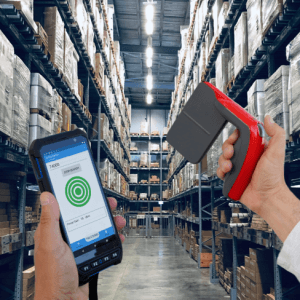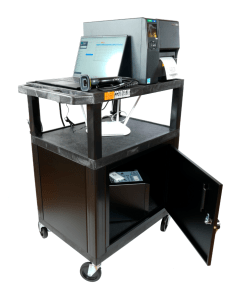
Introduction
The San Diego City Clerk’s office for archives and records management asked for help with a nagging problem. Retained records boxes would sometimes get misfiled in the 33,000 square foot warehouse. When a retrieval request for records in one of these boxes came in, an all hands hunt ensued to find that one box. It could take all of the warehouse staff days to locate a really well misfiled box. Aside from the warehouse staff having to stop their regular duties to look for the box, the city department requesting the contents was kept waiting. The compounded productivity losses were measurably impactful to city operations. Could there be a Superman X-ray vision technology to expedite the discovery of these renegade boxes, fast and affordably, so that the system would cover its cost within just a few months? The answer is yes. Most mislocated boxes are now found by one person in 15 minutes or less thanks to passive UHF labels and the Telaeris XPressFinder app.
Challenges
This is a large warehouse filled with thousands of banker boxes that all look alike except for some unique black and white labeling of a box serial number, barcode, and some other contents details. Most of these retained records remain on shelves, undisturbed for months, years, maybe decades while in compliance with California’s Local Government Records Management Guidelines. By and large, almost all boxes are filed accurately to where they belong in their cataloging system identified racks and shelves in the warehouse. The challenge is a practical solution for the times when this is not the situation.
Easy to implement was paramount. That meant an add-on technology for existing boxes already warehoused as well as to new boxes being enrolled into the archives. It needed to enhance the existing processes, not disrupt them.
Affordability was even more important. Like any city government, San Diego needed a solution that was financially justifiable and fast to prove its mettle with limited taxpayer cost. Being a fully self-contained add-on technology, Telaeris XPressFinder needs no integration to the existing archiving and cataloging software and needs no mechanical, electrical, or IT infrastructure. It’s a warehouse superhero waiting for the call to action.
Must be maintenance free, permanent technology. This means once a box is labeled with an RFID tag, the tag needs no further human touch. Some boxes could sit on shelves for decades and those RFID tags need to work just as effectively today and into future as prescribed by the retention guidelines.
Telaeris XPressFinder Goes to Work
The heart of XPressFinder is UHF passive RFID labels and a specialized handheld tag reader and Geiger counter-like app providing sights and sounds that draws the operator closer and closer to the target box. RFID uses radio waves to sense and read data content in tags, so boxes hidden from sight can still have their RFID tag data detected from as far away as 30 feet. The whole system conforms to the ISO 18000-6C RFID technology standard which was ratified in June, 2006, for use in supply chain box and pallet identification. Telaeris also supplied additional components to simplify implementation.

The RFID paper labels contain a high performance battery-free IC chip and antenna. The box ID is written to the chip and the pressure sensitive label is applied to the bankers box. To make things easier and faster, Telaeris supplied an optional printer/encoder and label design software on a notebook PC for this. For new boxes being enrolled into the archives, the RFID label is the singular identification label on the box with barcode, human readable print and the automatically encoded RFID chip, all the label data provided by the current archive cataloging software. For the many existing boxes in need of an RFID label upgrade, the Telaeris XPressLabel software uses a USB barcode reader to read that box’s barcode and print an identical barcoded RFID encoded label. The rework effort to upgrade the existing box takes seconds. The process is fully self contained on a wheeled cart to bring the labeling system to the warehouse shelves rather than the boxes to the printer. With optional battery power, the cart needs no extension cords.

The handheld RFID reader contains a highly directional antenna that projects a narrow radio beam forward. As the operator sweeps the handheld back and forth down the warehouse aisles, the Android app is constantly monitoring all the returning tag signals. When it detects a signal from the tag on the specific box number it was told is missing, the app lets the user know with color changing bullseye rings and ticking sounds. As the operator gets closer, the app automatically reduces the handheld’s transmit power level, challenging the operator to walk closer toward the target box to get a return signal from it. Upon locking in on the signal again, power is reduced again, requiring the operator to get even closer to the box. The operator is drawn to within a few feet of the box’s location, even if it is obscured from direct view. Finding the box at this point is a search limited to just a few boxes in one small area in 33,000 square feet of warehouse space.
Other Benefits of RFID Tagged Records Boxes
XPressFinder provides additional benefits beyond searching for an out of location records box. It can help with:
- Quickly identify records boxes that can be destroyed to open up shelf space
- Create an electronic record of boxes that have been moved or transported to a destruction site
- Reduce expenditures for new filing space or equipment
- Inventory and identify boxes that can be transferred to a low cost storage location
- Inventory sweep for misfiled confidential records compliance
Conclusion
Using long range passive UHF RFID technology at the San Diego City Clerk’s office for archives and records management saved time, labor, and ultimately cost when searching for out-of-place archived records boxes. Using radio waves and not vision or light permits XPressFinder to locate tagged boxes obscured from sight from up to 30 feet away. Just a few situations of everyone stop what you are doing and look for this box! recovered the cost of implementation. It’s intuitive interface and adjustable power settings reduced the task to one person and 15 minutes to find a box.
XPressFinder is a standalone solution that needs no software integration into an existing records cataloging software. The two run side by side independently enhancing productivity. The XPressFinder labeling cart on wheels is a self contained label retrofit station that brings on-demand tag encoding and label printing to the boxes on the shelves for faster deployment.
RFID tagged boxes also lend themselves to other optional benefits including making more efficient use of space and filing hardware by helping identify boxes that are past retention expiration for removal and destruction.
Contact us to learn how XPressFinder can improve your records retention operations.
